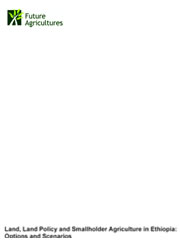 Land is a public property in Ethiopia. It has been administered by the government sincethe 1975 radical land reform. The reform brought to an end the exploitative type of relationship that existed between tenants and landlords. Tenants became own operators with use rights, but with no rights to sell, mortgage or exchange of land. The change of government in 1991 has brought not much change in terms of land policy. {jathumbnail off}
Land is a public property in Ethiopia. It has been administered by the government sincethe 1975 radical land reform. The reform brought to an end the exploitative type of relationship that existed between tenants and landlords. Tenants became own operators with use rights, but with no rights to sell, mortgage or exchange of land. The change of government in 1991 has brought not much change in terms of land policy. {jathumbnail off}
The EPRDF led government that overthrew the Military government (Derg) in 1991 has inherited the land policy of its predecessor. Even though the new government adopted a free market economic policy, it has decided to maintain all rural and urban land under public ownership. The December 1994 Constitution of the Federal Democratic Republic of Ethiopia proclaimed that ‘Land is a common property of the nations, nationalities and peoples of Ethiopia and shall not be subject to sale or to other means of transfer’.
Since the 1975 land reform, which made all rural land public property, the possession of landplots has been conditional upon residence in a village. The transfer of land through longterm lease or sales has been forbidden1, and government sponsored periodicredistribution, though, discouraged administratively since the early 1990s, has not been outlawed (Mulat, 1999). Ethiopia is one of the few countries in Africa that has not made significant changes in its basic land policy for over three decades; except for occasional land redistributions to accommodate the growing population.
Land redistribution was more frequent during the Derg time and has been discouraged since 1991, though not totally eliminated. No redistribution has happened for 10 years in Amhara Region, 15 years in other regions. In1996, land was given to landless youth and returnee ex-soldiers in Amhara Region by reducing the holding of farmers who were reportedly associated with previous governments. Even though equity or social justice seems the major objective of there distribution, it also demonstrates the loophole in the policy which allows local authorities to use the land policy as a political instrument. In other regions, communal grazing and woodland was allotted to new claimants (Mulat, 1999).
Increasing population in the rural areas was thus absorbed in agriculture through levelling down of holdings,rather than through alternative forms of employment. Population growth could have been supported by rural non-farm employment creation, but this hasn’t happened so young adults people remain in rural areas either unemployed, as landless labourers or as share croppers on someone else’s land. This consequence of the land redistributions and the current land policy does not seem to have been foreseen by the government of Ethiopia.
Access to land is an important issue for the majority of Ethiopian people who, one way orthe other, depend on agricultural production for their income and subsistence. Landtenure issues therefore continue to be of central political and economic importance, as they have been at several junctures in Ethiopia’s history.
{jathumbnail off}
